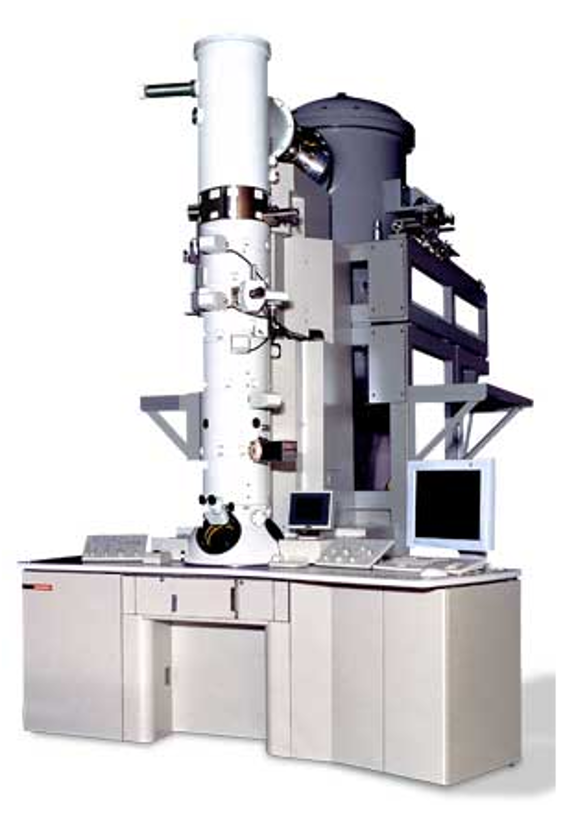As mentioned above and in several additional places on these web pages, the 3200FS is connected to a number of computers. The microscope itself has a microprocessor (referred to as the "VME") that controls its hardware (high tension, vacuum system, stage, apertures, etc.). This layer of computing is mostly invisible to the user, though there are certain occasions and conditions where it is important to understand that it exists and to make sure it is functioning properly.
There are three PCs which make up the conventional "user interface" to the 3200FS (and it's cameras/detectors) and two additional PCs that add functionality to the 3200FS and its computers. The diagram to the right shows how these computers are connected and highlights the fact that the only "internet connection" to the 3200FS is a dedicated line running from the 3200FS to the JEOL PC (described immediately below).
JEOL PC
The JEOL PC (aka, the TEMcon PC) supports TEMcon (the user interface that controls the 3200FS), TEMserver (the communication agent that connects TEMcon to the microprocessor in the 3200FS), and JEOL's SimpleImageViewer (a program that controls the STEM detectors and displays the BF-STEM or HAADF-STEM images that the detectors acquire). Many of the microscope features are normally controlled via TEMcon (instead of the knobsets on the microscopes console) and all the information that a user needs (magnification, spot size, defocus, accelerating voltage, energy filter state, lens and deflector currents, etc.) are displayed for the user to see via TEMcon. This PC has two network cards, one that connects the PC to the microprocessor in the microscope and a second that connects the PC to the outer world (in our case, to the IU Bloomington network, but not to the world in general). This arrangement means that the microscope itself is isolated from everything except this particular PC.
Gatan PC
The Gatan PC is physically connected to the UltraScan CCD camera and to DigiScan (Gatan's STEM control unit). It is networked to the PC that controls the Oxford EDX detector and to the JEOL PC. There is also a photo quality printer connected directly to the Gatan PC. The Gatan PC is the platform for both DigitalMicrograph (DM) (Gatan's user interface to virtually everything) and serialEM (the tomography data acquisition software from the Boulder Laboratory for 3-D Electron Microscopy of Cells). Both DM and serialEM can control the 3200FS, and DM can additionally control the Oxford EDX detector. In addition to the "permanent" and necessary network connections to the PCs in the microscope room, the Gatan PC has a similar required connection to a Linux PC (described below) in the room that houses the Vitrobot Mk3. The Gatan PC is connected via its single network card to the IU Bloomington network, and it is this network connection that allows the Gatan PC to communicate with the other computers.
Oxford PC
The Oxford PC is directly connected to the Oxford EDX detector and networked to both the JEOL and Gatan PCs. In addition, the Oxford PC is directly connected to a small color document printer. This PC is also connected via its single network card to the IU Bloomington network.
Note: Because of all these interconnections between the different PCs, the various cameras and detectors and the 3200FS itself, please do not reboot any of these machines. If you think it is necessary to reboot any of these machines, please contact the staff.
In addition to the three PCs that are in the room with the 3200FS, there are two other PCs involved in the operations of the 3200FS:
Linux PC
The Linux PC is located in the room (032B) that holds the Vitrobot Mk3. The primary function of this PC is that it has the Lustre filesystem of the WAN area of the IU Data Capacitor directly mounted on it across the campus network. In this configuration, we are then able to put that same Lustre filesystem onto the Gatan PC as a "networked drive" (which appears as a single >400 TByte disk). This in turn allows the Gatan PC to save images and spectra directly to the Data Capacitor (which is the major reason every user of the 3200FS needs a computer account on Quarry). In addition, this PC has many of the image processing programs needed for data analysis installed on it (though it is not powerful enough to be a computational workhorse). Finally, the Linux PC is the only machine where USB devices can be used to download images and spectra.
Sirius PC
The Sirius PC is currently located in David Morgan's office. The name "Sirius" derives from JEOL's "Sirius remote operation software" which allows a user with network access to the PCs that control the 3200FS to control all aspects of the microscope. The Sirius installation includes a partial knobset for microscope control and a track-ball for stage movement that are directly connected to the Sirius PC. These control devices and the software itself give a remote user access to anything the 3200FS can do (with the obvious exception of something like physical insertion of a specimen into the microscope). Because the JEOL, Gatan and Oxford PCs are available to the IU Bloomington campus network, it would be possible to move the Sirius PC to any location on the campus and to operate the 3200FS from there. If there are sufficient reasons to do so, we would also be able to make the JEOL, Gatan and Oxford PCs accessible from anywhere in the world and to operate the 3200FS from this Sirius PC (or a similarly enabled PC) anyplace with a (fast enough) network connection.
